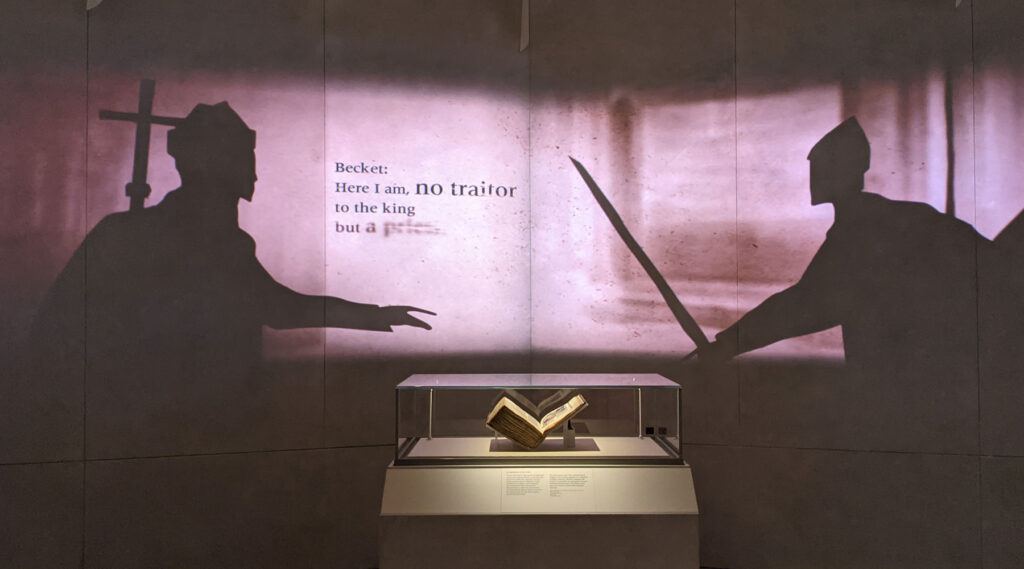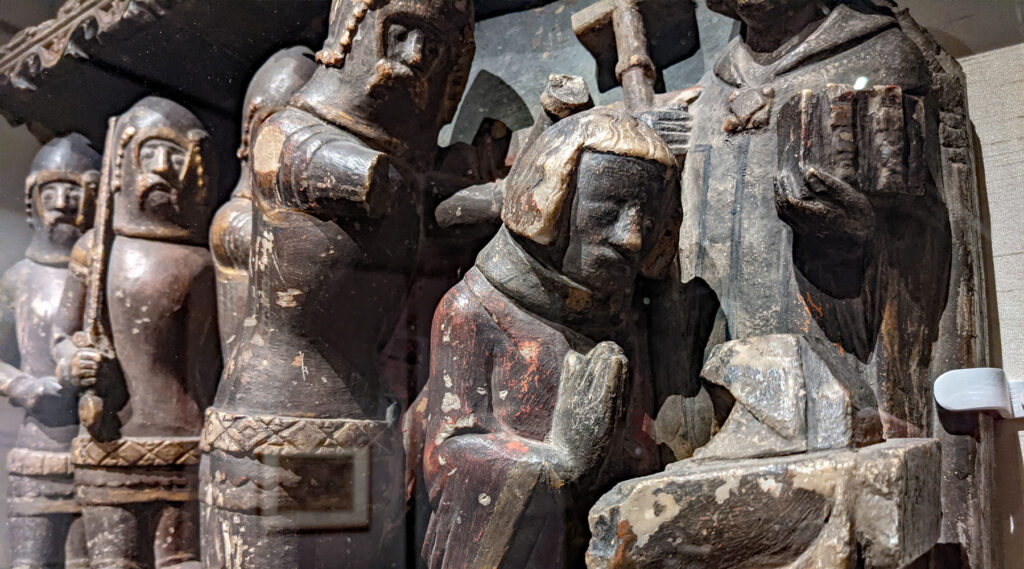It’s the classic ageless story.
Man meets King. Man gets favours from King. Man becomes Bishop. King banishes Bishop. Bishop returns. King kills Bishop. Dead Bishop becomes Saint.
Of course, it’s a thousand times more complicated than that, but for many people, the story of Thomas Becket is limited to the famous murder, and maybe the hairshirt.
His death 851 years ago is the impetus for this delayed by a year 850th-anniversary exhibition at the British Museum. It’s not an exhibition that seeks to educate in great depth about the much bigger story, but to show off the Bishop and Saint, and more specifically how he was remembered after death.
It’s Becket Bling first and foremost.
The exhibition opens with an astonishing gold and blue enamel casket that once contained a relic of the saint. It’s one of the oldest and largest cases of this sort to survive, dating to just 20 years after Becket’s death, and the expense of the decoration shows that just 20 years after his infamous death, his fame and sainthood was able to justify the cost of such a richly decorated casket.
With 850 years between Becket’s death and modern times, it’s not surprising that few items have survived the centuries, and many in the exhibition are labelled with variants of “only known example of”, giving the exhibition an air of exclusivity.
It’s not that many of the items on display are unique objects – old books, old religious icons, old carvings, but they are unique for being associated with just the one man who defied a King and became deified in turn.
…very quickly you would turn your heart and favour away from me, which is now so great between us, and replace it with the most savage hatred… Becket speaking to Henry II in 1162

A triptych made around the time of Becket’s dispute with King Henry showing God as the ultimate authority
The dominant image of the man today is of his murder, often shown praying while the four knights are lining up as if for a bus queue waiting their turn to do in the troublesome bishop. It’s post-sainthood propaganda to remind people how saintly and good the usually carefully very carved bishop was, and how depraved the usually generic-looking knights were in their deed.
A book, with the inscription suggesting that it belongs to Becket, was thought to be dubious until recent research found a match in the Cathedral records from 1300, so it could well be his.
The centrepiece of the exhibition though is one of the Miracle Windows, brought from Canterbury Cathedral for the first time ever, and here shown in four pieces side by side rather than in a tall column. That makes it much easier to see up close what is normally seen from far down below, and they’ve chosen the window with the miracle of the regrowing genitals.
The difficulty I found with the backlit display is that it felt a bit artificial, almost as if it was part of the stage scenery for the exhibition rather than a major historic item in its own right.
It’s wonderful intellectually to see the window up close in this way, but emotionally it missed the spot.
In addition to the stained glass windows, there used to be a huge shrine to the saint in the Cathedral, but it was destroyed on the orders of another Henry, this time King Henry VIII, but a chunk of stone was discovered in 1984, dumped in a local river.
…from henceforth the said Thomas Becket shall not be esteemed, named, reputed, nor called a saint but Bishop Becket and … his images and pictures through the whole realm shall be put down… Royal Proclamation, 16th November 1538
Possibly the most disturbing items on display, from a modern perspective of avoiding book burning and censorship, are three books that have been edited to remove or obscure references to the Saint.
One had pages cut out, another had the references inexpertly crossed out, but to my mind, it’s the red ink-stained book that was just a bit too close to looking blood-stained for that to be an accidental choice of colour to obscure the saint.
That hit the emotional spot missed by the stained glass earlier.
To this day the debate about Becket endures. Was he a godly man upholding his beliefs, or a traitor who defied a King?
This is not an exhibition that will answer that question, for it has defied answers for centuries. It is, however, a delayed by a year, anniversary opportunity to see a lot of very rare and beautiful Becket Bling in one place for probably the last time until the 900th anniversary, so take the opportunity.
It’ll probably be another 49 years before you can see all these items in one place again, so that makes it a genuine “must-see exhibition”.
The exhibition, Thomas Becket – Murder and the making of a saint opens later this week at the British Museum and runs until 22nd August.
Tickets cost from £17 for adults – free for members and children until 16. Must be booked in advance from here.
Exhibition Rating
18 Stafford Terrace
18 Stafford Terrace, Kensington, London
W8 7BH












